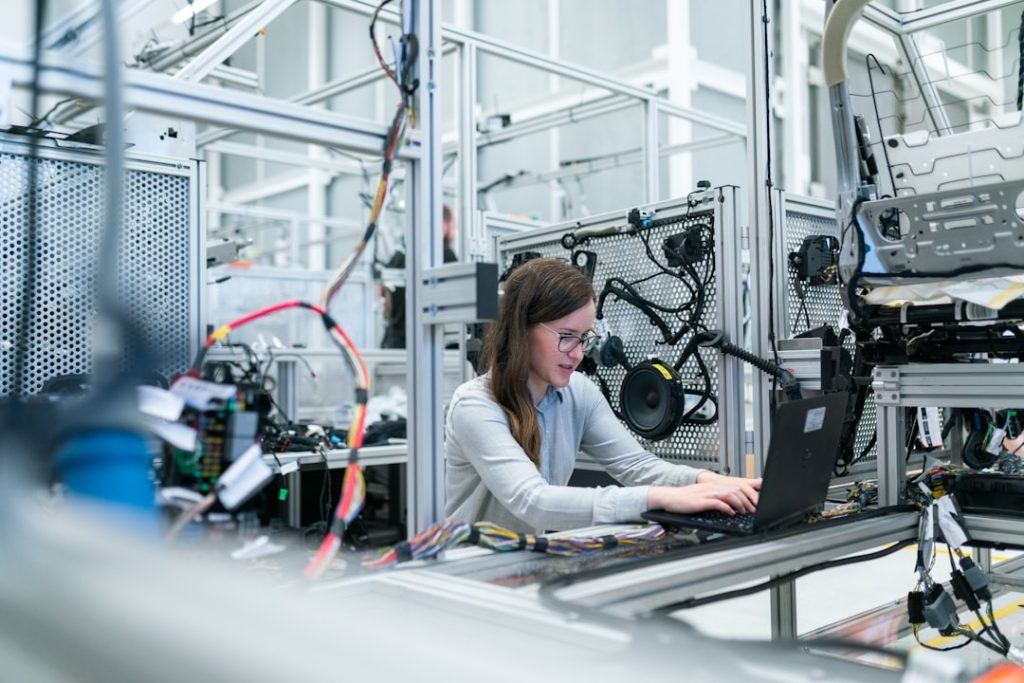The world of Audio-Visual (AV) technology is constantly evolving, impacting various sectors from entertainment to healthcare. The future promises even more integration, innovation, and improvements in user experience. In this article, we will explore the future of AV technology, focusing on its environmental impact, accessibility, cost-benefit analysis, case studies, and its application across different sectors.
The Environmental Impact of AV Technology

As AV technology advances, it’s crucial to consider its environmental impact. Modern AV systems are becoming more energy-efficient, reducing their carbon footprint. For instance, LED displays consume significantly less power than traditional LCD screens. Moreover, advancements in smart technology allow for better energy management, turning off devices when not in use.
Sustainable Materials
Manufacturers are increasingly using sustainable materials in the production of AV equipment. Recyclable metals and biodegradable plastics are becoming standard, reducing waste and promoting a circular economy. Additionally, companies are designing products that are easier to upgrade and repair, extending their lifespan and reducing the need for replacements.
The use of sustainable materials also includes sourcing from responsible suppliers who follow eco-friendly practices. This ensures that the entire supply chain supports sustainability efforts. Furthermore, some manufacturers are exploring bio-based materials, which have a lower environmental impact compared to traditional plastics and metals.

Green Certifications
Many AV products now come with green certifications such as Energy Star or EPEAT, indicating their compliance with environmental standards. These certifications help consumers make informed decisions, ensuring that their purchases are environmentally friendly.
Green certifications are not just about energy efficiency; they also cover aspects like reduced use of hazardous substances and improved recyclability. Manufacturers must meet stringent criteria to earn these certifications, which often involve third-party testing and verification.
Energy Management Innovations
Smart technology advancements are enabling better energy management in AV systems. Devices can now automatically power down when not in use, significantly reducing energy consumption. Additionally, integrated energy monitoring tools allow users to track and optimize their energy usage.

Energy management solutions extend to entire networks of AV equipment, enabling centralized control and automation. For instance, a smart home system can manage multiple AV devices, ensuring they operate only when needed. This holistic approach to energy management contributes to a substantial reduction in overall energy consumption.
Accessibility in AV Technology

Accessibility is a crucial aspect of modern AV technology. Ensuring that everyone can use and benefit from these technologies is a priority for developers and manufacturers.
Assistive Technologies
Innovations in AV technology have led to the development of various assistive tools. For example, screen readers and voice recognition software enable visually impaired users to navigate and interact with AV systems. Similarly, closed captioning and sign language interpretation make content accessible to those with hearing impairments.
Assistive technologies are also incorporating AI to provide more accurate and responsive assistance. For instance, AI-powered screen readers can offer better context and understanding of on-screen content. Additionally, real-time translation services are becoming more prevalent, breaking down language barriers and making AV content accessible to a global audience.

Inclusive Design
Inclusive design principles are becoming more prevalent in the AV industry. This approach ensures that products are usable by as many people as possible, regardless of their abilities. Features such as adjustable font sizes, high-contrast displays, and customizable interfaces cater to a wide range of users, promoting inclusivity.
Inclusive design goes beyond just physical accessibility; it also considers cognitive and sensory needs. For example, simplifying user interfaces and providing multiple input options can help users with different cognitive abilities. By adopting inclusive design, AV technology can create more equitable experiences for all users.
Regulatory Compliance
Regulations and standards play a significant role in promoting accessibility in AV technology. Laws like the Americans with Disabilities Act (ADA) require that public AV systems be accessible to individuals with disabilities. Compliance with these regulations ensures that AV technology can be used by everyone, regardless of their physical or cognitive abilities.

Governments and organizations are continually updating these regulations to keep pace with technological advancements. This ensures that new AV innovations are accessible from the outset, rather than requiring retrofitting or adaptations later on.
Cost-Benefit Analysis of AV Technology
Investing in AV technology can be costly, but the benefits often outweigh the initial expenses. A thorough cost-benefit analysis can help organizations and individuals make informed decisions about their AV investments.
Initial Costs vs. Long-Term Savings
While the initial cost of advanced AV systems can be high, they often lead to long-term savings. Energy-efficient devices reduce electricity bills, and durable, high-quality equipment minimizes the need for frequent replacements and repairs. Additionally, advanced AV systems can enhance productivity and efficiency, leading to indirect cost savings.
Long-term savings also come from reduced operational costs. For example, automated AV systems can lower labor costs by reducing the need for manual operation. Furthermore, the longevity of high-quality AV equipment means fewer disruptions and downtime, which can have significant financial benefits.

Return on Investment (ROI)
For businesses, the ROI of AV technology can be significant. High-quality AV systems can enhance presentations, improve communication, and create more engaging experiences for clients and employees. In educational settings, advanced AV tools can facilitate learning and improve student outcomes, justifying the investment.
ROI is not just about financial returns; it also includes non-monetary benefits such as improved brand perception and customer satisfaction. For instance, a business that invests in cutting-edge AV technology can project an image of innovation and excellence. Similarly, educational institutions that adopt advanced AV tools can attract more students and faculty.
Financial Incentives and Grants
There are various financial incentives and grants available to support the adoption of AV technology. Governments and organizations often provide funding to promote the use of energy-efficient and accessible AV systems. These financial aids can significantly reduce the initial investment required, making advanced AV technology more accessible to a wider audience.

Businesses and institutions can take advantage of tax credits, rebates, and other financial programs to offset the cost of AV technology. By leveraging these incentives, they can make more cost-effective decisions and maximize the benefits of their AV investments.
Case Studies of AV Technology
Real-world examples illustrate the diverse applications and benefits of AV technology across different sectors.
AV in Entertainment
In the entertainment industry, AV technology is revolutionizing the way we consume media. High-definition displays, immersive sound systems, and virtual reality (VR) experiences are just a few examples of how AV technology enhances entertainment. Companies like Netflix and Disney+ invest heavily in AV technology to deliver high-quality streaming services to their audiences.
The use of AV technology extends to live events and performances, where advanced lighting and sound systems create unforgettable experiences. For example, concerts and theater productions use state-of-the-art AV equipment to provide audiences with immersive and engaging performances. Additionally, theme parks are incorporating AV technology to create interactive and dynamic attractions.

AV in Healthcare
In healthcare, AV technology plays a crucial role in improving patient care and medical training. Telemedicine platforms enable remote consultations, reducing the need for in-person visits and increasing access to healthcare services. Additionally, advanced AV tools such as 3D imaging and augmented reality (AR) assist in surgical planning and medical education, providing doctors and students with detailed, interactive visualizations.
AV technology is also being used to enhance patient experiences in hospitals. For instance, digital signage and interactive displays can provide patients with information and entertainment, making their stay more comfortable. Moreover, AV systems can support remote monitoring and diagnostics, allowing healthcare providers to deliver timely and effective care.
AV in Education
Educational institutions are increasingly adopting AV technology to enhance teaching and learning. Interactive whiteboards, digital projectors, and online learning platforms create engaging and dynamic learning environments. These tools facilitate collaboration, accommodate different learning styles, and provide access to a wealth of digital resources.
Distance learning and virtual classrooms have become more prevalent, supported by advanced AV technology. Students can participate in live lectures, access recorded sessions, and engage with interactive content from anywhere in the world. This flexibility and accessibility have transformed the educational landscape, making learning more inclusive and effective.

AV in Corporate Settings
In the corporate world, AV technology is transforming the way businesses operate. Video conferencing systems, digital signage, and collaborative tools enable seamless communication and information sharing. These technologies support remote work, enhance productivity, and create more interactive and engaging workspaces.
Corporate training programs are also benefiting from AV technology. Virtual reality (VR) and augmented reality (AR) can create realistic training scenarios, allowing employees to practice skills and procedures in a safe and controlled environment. This hands-on approach to training can improve retention and performance, leading to better outcomes for businesses.
AV in Retail
Retailers are leveraging AV technology to create immersive shopping experiences and engage customers. Digital signage, interactive displays, and in-store audio systems can attract attention and provide valuable information to shoppers. Additionally, AV technology can support personalized marketing, offering tailored promotions and recommendations based on customer behavior.

AV technology is also being used to streamline operations and improve efficiency in retail settings. For example, smart shelves and inventory management systems can track stock levels and provide real-time data to staff. This ensures that products are always available, enhancing the customer experience and driving sales.
The Future of User Experience in AV Technology
User experience (UX) is a critical factor in the success of AV technology. Future advancements will likely focus on making AV systems more intuitive, responsive, and personalized.
Intuitive Interfaces
Developers are working on creating more user-friendly interfaces that require minimal training. Voice-activated controls, gesture recognition, and AI-powered assistants are examples of how AV systems are becoming easier to use. These features allow users to interact with technology naturally and efficiently.
User interfaces are also becoming more adaptive, responding to user behavior and preferences. For instance, an AV system might learn a user’s preferred settings and automatically adjust to provide a seamless experience. This adaptability can reduce friction and enhance overall satisfaction.

Personalization
Personalization is another key trend in AV technology. Systems that adapt to individual preferences and behaviors can provide tailored experiences. For instance, smart TVs that recommend content based on viewing habits or conference room systems that adjust settings based on the user’s profile are examples of how personalization enhances UX.
Personalization extends to various aspects of AV technology, including audio settings, display preferences, and content recommendations. By leveraging data and analytics, AV systems can offer more relevant and engaging experiences. This level of customization can improve user satisfaction and foster stronger connections with the technology.
Enhanced Interactivity
Future AV technology will likely offer more interactive experiences. Touchscreens, VR, and AR are becoming more sophisticated, providing users with immersive and engaging interactions. These technologies can be applied in various fields, from gaming and entertainment to education and training, offering new ways to engage and learn.
Interactive AV technology is also being used in public spaces and installations. For example, museums and exhibitions are incorporating interactive displays to provide visitors with engaging and informative experiences. These interactive elements can enhance learning and make information more accessible and memorable.

Seamless Integration
The future of AV technology will also see more seamless integration with other smart systems and devices. This interconnectedness will create cohesive and holistic experiences, whether in smart homes, offices, or public spaces. For instance, an AV system might work in tandem with a smart lighting system to create the perfect ambiance for different activities.
Seamless integration will enhance convenience and efficiency, allowing users to control multiple aspects of their environment from a single interface. This level of integration can streamline operations and provide more cohesive and enjoyable experiences.

Conclusion
The future of AV technology is bright, with advancements promising to enhance various aspects of our lives. From reducing environmental impact and improving accessibility to offering significant cost benefits and transforming industries, AV technology is set to play a crucial role in our future. As technology continues to evolve, we can expect even more innovative and user-friendly solutions that will shape the way we interact with the world around us.
By staying informed about these trends and advancements, individuals and organizations can make strategic decisions to harness the full potential of AV technology. Whether in entertainment, healthcare, education, or corporate settings, the future of AV technology holds exciting possibilities.

By embracing these advancements, we can create a more connected, sustainable, and inclusive world. The opportunities are vast, and the potential for positive impact is immense. The future of AV technology is not just about technological progress; it’s about enhancing human experiences and improving our quality of life.
